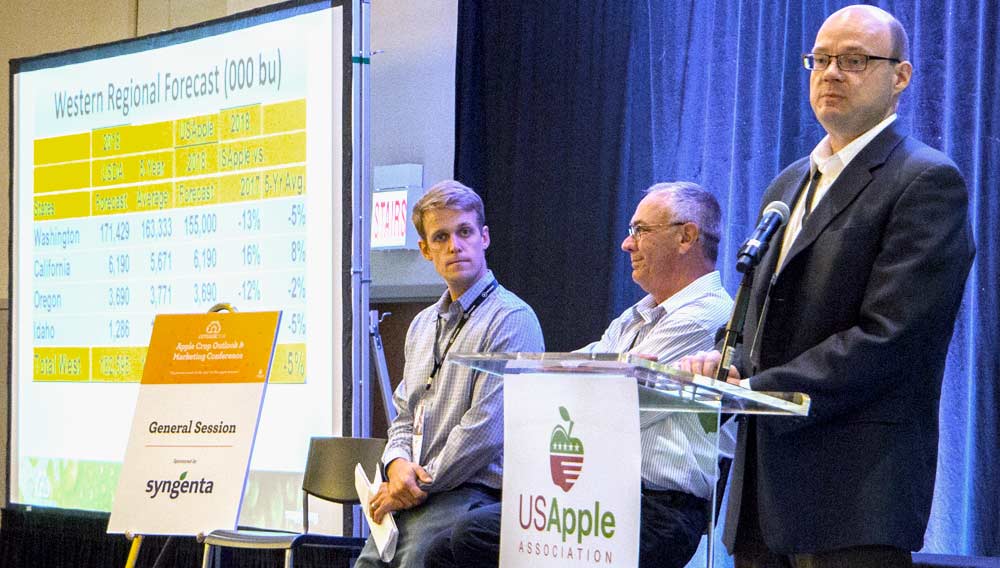
Washington State Tree Fruit Association President Jon DeVaney stands at the lectern during a panel discussion during the US Apple Outlook on Friday, Aug. 24, 2018 in Chicago. DeVaney told attendees that Washington’s total apple crop has been revised downward from 182.6 million bushels to 155 million bushels. (Ross Courtney/Good Fruit Grower)
Growers and industry officials at the US Apple Outlook on Friday in Chicago forecast a nationwide apple crop 256.2 million 42-pound bushels, which would be 6 percent lower than last year’s crop and 2 percent below the five-year average.
Friday’s estimate, gathered from regional discussions at the meeting, also came in 6 percent lower than the U.S. Department of Agriculture’s estimate released Aug. 10, largely because of changes in Washington so far this harvest, said Jon DeVaney, president of the Washington State Tree Fruit Association, who helped compile the figures.
After a few weeks of picking, growers in Washington have revised their first estimate to 155 million bushels, down from the earlier figure of 182.6 million bushels, DeVaney said.
Washington is expected to produce 61 percent of the nation’s apples this year.
Elsewhere, the Midwest region expects to harvest about 31.6 million bushels, a 35 percent jump over 2017, when Michigan suffered considerable frost damage, said Mike Rothwell, president and CEO of Belle Harvest Sales in Belding, Michigan. Michigan is predicted to grow 89 percent of the Midwest’s apples. The total Midwest crop should be 8 percent over the five-year average.
A rainy late spring and summer might affect size development for East Coast producers, said Joel Crist, of Crist Bros. Orchards in Walden, New York. However, growers expect a crop of 58.4 million bushels, about even with both 2017 and the five-year average.
All the figures estimate total production, including fresh and processing apples.

Ag trucking lobbyist Jon Samson talks about how DC has moved from ELD mandate to seeking flexibility in hours of service during the USApple meeting in Chicago on Friday, Aug. 24, 2018. (Ross Courtney/Good Fruit Grower)
Trucking concerns
Earlier Friday, industry members got an update on trucking issues.
The fretting over the Electronic Logging Device mandate for the trucking industry has subsided and been replaced by lobbying for more flexibility in the hours of service regulations, said Jon Samson, executive director of the Agricultural and Food Transporters Conference, part of the American Trucking Associations.
In fact, the ag trucking industry did not unanimously oppose the devices, called ELDs, in the first place. The concern was making sure the ELDs recognized when a driver was operating under the agricultural exemptions already in place.
The agricultural trucking industry also is pushing lawmakers and regulators to relax the driving age restrictions. Currently, most states require truckers be at least 18 to haul within that state, but crossing state lines requires a driver be at least 21, according to federal rules. Lowering that to 18 would go a long way to mitigating the long-haul truck driver shortage, currently estimated at 51,000 drivers, Samson said.
—by Ross Courtney
Click here for an overview of Day 1 at the US Apple Outlook.






Leave A Comment